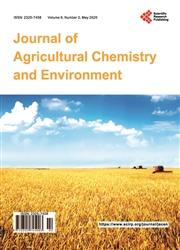Heavy Metal Bioaccumulation by Maize Grown on a Ferralsol Amended with Urban-Based Biosolid Wastes
引用次数: 0
Abstract
Organic waste materials as soil amendments are one of the topical approaches applauded for achieving sustainable agriculture world-over. The objective of this study was to investigate the effect of urban-based biosolid waste (UBBW) application on heavy metals (Cr, Cu, Zn and Pb) bioaccumulation by maize (Zea mays L.) plants. A pot experiment was conducted three times, using an acid Ferralsol from Makerere University Agricultural Research Institute, Kabanyolo (MUARIK) in Uganda. Treatments included the application of three types of UBBW, namely sewage, brewery and abattoir, each applied independently at the rates of 0, 50 and 100 g per pot filled with 4 kg soil. This was equivalent to 0, 2.5 and 5.0 metric tonnes of dry materials per hectare. Phosphorus fertiliser was also applied at 0, 0.795 and 1.591 g P per pot, equivalent to rates of 0, 25 and 50 kg P ha-1. The brewery waste applied at rates ≥ 2.5 t·ha-1 and phosphorus at 25 kg P ha-1 resulted in shoot Cu concentrations below the World Health Organisation (WHO) safe limit (73.3 mg·kg-1); and Zn slightly above the WHO safe limit (99.4 mg·kg-1). In contrast, the concentrations of chromium in the maize plants were well above the WHO safe limit (2.3 mg·kg-1), irrespective of the applied type of UBBW. Shoot metal bioaccumulation followed the order zinc > copper > chromium, with Pb being below the detection limit. The safest UBBW was abattoir waste; while the least environmentally suitable was sewage waste. It is clear that irrespective of the type of UBBW, their application to Ferralsol causes less bioaccumulation of Pb and Cr in maize plants compared to Zn and Cu.城市生物固体废弃物改性土壤中玉米重金属的生物积累
有机废弃物作为土壤改良剂是世界范围内实现可持续农业的热门方法之一。本研究旨在探讨城市生物固体废弃物(UBBW)对玉米(Zea mays L.)植株重金属(Cr、Cu、Zn和Pb)生物积累的影响。使用来自乌干达卡巴约洛Makerere大学农业研究所(MUARIK)的酸性Ferralsol进行了三次盆栽试验。处理包括施用三种类型的UBBW,即污水、啤酒厂和屠宰场,每一种分别以0、50和100克的速度独立施用,每罐填满4公斤土壤。这相当于每公顷0、2.5和5.0公吨的干材料。每盆施磷肥分别为0、0.795和1.591 g,相当于0、25和50 kg磷肥每公顷。≥2.5 t·kg-1施磷量和25 kg P·ha-1施磷量导致茎部Cu浓度低于世界卫生组织(WHO)安全限值(73.3 mg·kg-1);锌略高于世界卫生组织安全限值(99.4 mg·kg-1)。相比之下,玉米植株中的铬浓度远高于世卫组织的安全限值(2.3 mg·kg-1),与施用的UBBW类型无关。茎部金属生物富集顺序为锌>铜>铬,Pb低于检出限。最安全的UBBW是屠宰场废物;而最不适合环境的是污水。很明显,无论何种类型的UBBW,与锌和铜相比,它们在Ferralsol中的应用导致玉米植株Pb和Cr的生物积累较少。
本文章由计算机程序翻译,如有差异,请以英文原文为准。
求助全文
约1分钟内获得全文
求助全文

 求助内容:
求助内容: 应助结果提醒方式:
应助结果提醒方式:


